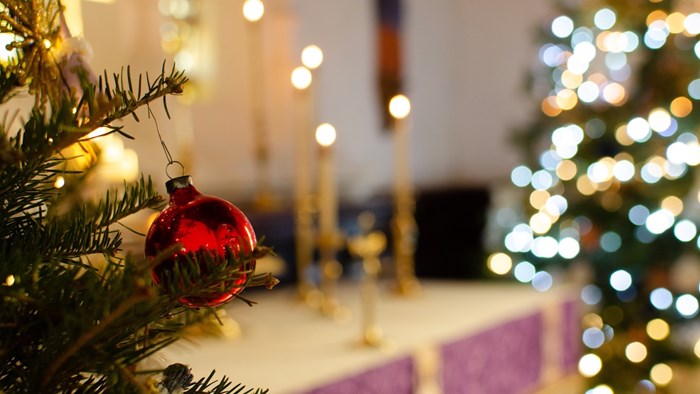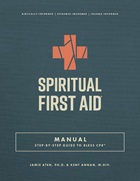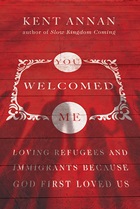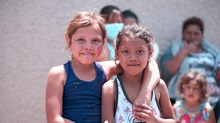An Advent Guide for Better Samaritans

Five years ago, some friends gave up electricity at home for Advent, using their devices only at work, living by candlelight in the mornings and evenings, grocery shopping in smaller batches, and restocking their cooler-turned-fridge on the porch. I was familiar with participating in creative fasts during Lent, but hadn’t considered doing something for Advent, besides lighting candles, opening calendars, and reading devotionals. My imagination was sparked! What would it look like to prepare for Advent the way I did for Lent, to engage the whole Advent season with a little more of Lent’s vim and vigor?
It turns out Advent responds very well to a little forethought and creativity. It means “arrival” or “coming,” and marks the four weeks leading up to Christmas. In Advent, we not only look back to Christ’s first coming as a human born to refugees (“and they ran and they ran and they ran”), but we also look forward to Christ’s second coming. There’s a connotation of waiting with Advent, but for me it’s less like waiting at a stop light, and more like my computer’s spinning cursor, which says at once: “Hold your horses, slow down,”as well as “Working on it...something’s coming.”
The last few years, I’ve been engaging more fully in Advent, and each time my internal clock feels a little more naturally set to the liturgical one, sinking a little more easily into Advent-specific rhythms and practices. For this year, I’m already starting to wonder, “What would make a good Advent? What’s God doing in my life and in my relationships, on my block and in my community and what does Advent have to offer, impart, or teach us? What are the invitations this year?”
As a way to discern that, I’ve put together a How To Advent (Better) Guide, specifically with The Better Samaritan audience in mind, as kindreds interested in practicing what we preach and making love concrete.
Before you peruse this guide, here are 7 features of Advent that I have come to care about. I offer them to you for consideration as you wonder about what’s important to you this season, and how God is inviting you to respond:
Attention: Advent isn’t about how much time I have or how much money I have to spend on gifts, but that one of the best gifts I can give God and others is my attention. Attention is free (ish) and a little can go a long way! How do we respond to those spontaneous bids for our attention that happen throughout the day, initiated by the Spirit, people we love, and by people we may not even know?
Longing: Advent’s main invitation to me is always some version of getting more in touch with my longings; turning the volume up on desire, not down; becoming more human, not less. What are God’s dreams for the world and its inhabitants? What are mine?
Darkness isn’t “bad”: Like a bright star against a night sky, the themes of darkness and light show up a lot during Advent. Every year I need to remember the false correlation between darkness as bad and light as good, and how that translates to a racially-insensitive hierarchy of whiteness over blackness. For a beautiful introduction into these themes for children and adults alike, see God’s Holy Darkness by Sharei Green, Beckah Selnick and Nikki Faison.
December is sad: The original Advent and Christmas held life, yes, but also death; wonder of course, but also weeping. The commercialization and sentimentalism of Christmas prep can numb me to the reality that this “most wonderful time of the year” can simply also be the hardest time of the year, because of how it highlights who is near and dear to us, and who is not, and the families and resources we do or do not have.
Beware of baby: All of the pregnancy, birth, baby and family imagery of this season can be especially painful for those who have experienced miscarriages, the loss of a child, unexplained infertility, or the desire to be partnered or pregnant. May we all become more sensitive to not only how triggering these Christmas themes can be for people in different seasons of life, but also to the empowering reality that most often the words we most need to hear come through each other.
111 Women: In her introduction to Year W (a women’s lectionary), Rev. Wil Gafney says that there are at least 111 named women in the Hebrew testament and that most of us probably can only come up with 10! In Advent, I want to pay attention to “Scripture’s most neglected population'—women and girls.
Help: I can’t do Advent alone, I need help. I’ve never regretted the time and money spent on an Advent retreat (see below), a conspiring dialogue about how to consume less, or a reflective conversation with friends about what we’re hoping for this season, what’s important, and what gets in the way. It’s authentic to Advent to admit that we can’t do this alone, that everything’s crowded, that we need mercy, and that together, we can do Advent better.
Ready to dive in? Get your free copy of the guide.
Vanessa Caruso is a spiritual director and supervisor based in Victoria, BC. She is passionate about children, spiritual practices, ocean dips, poetry, and pies (both chicken pot and cherry). She’s been married to her husband for 18 years; they have an expressive 9 year old son and a prehistoric-looking bearded dragon lizard named Fifi.
The Better Samaritan is a part of CT's
Blog Forum. Support the work of CT.
Subscribe and get one year free.
The views of the blogger do not necessarily reflect those of Christianity Today.






















